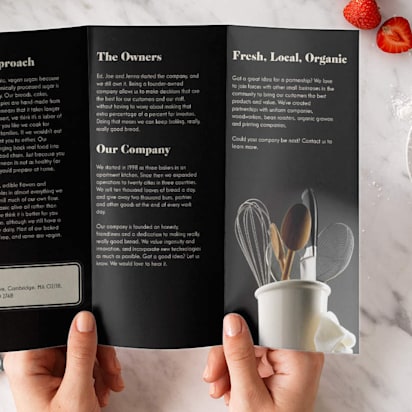Table of Contents
Even though they exist in different spaces and may serve different purposes, websites and physical shopfronts actually have a lot in common. They communicate your brand, showcase your offerings, engage your visitors and contribute to your bottom line. Because of these similarities, the principles that apply to successful visual merchandising in a physical shop can be used to make your website a success too!
Whether you’re starting an online presence from scratch, or refreshing a website you already have, check out these eight expert tips for shop merchandising and how you can apply them to your website today:
1. Build on your brand
“Your plan for your window design should enhance your business brand … Incorporate the fonts and colours of your brand into any signage.”
Small Business Trends

Website takeaway: Having a consistent brand across your print and digital marketing materials (70% of micro businesses use both) goes a long way toward giving your business a polished, professional appearance. Draw inspiration from your business cards, brochures and signs when adding your logo, images, colours and fonts to your website and not only will you end up with a great-looking site, you’ll also strengthen the brand you’ve built for your business.
2. Update your displays
“You want to change your windows as often as possible, but it doesn’t have to be a costly, time-consuming effort … At the very least, update your displays every one to two months. The more often you change your windows, the more people will look at your shop.”
Entrepreneur

Website takeaway: A recent study by Vistaprint Digital found that 68% of consumers say up-to-date and accurate website content is most important when it comes to having a positive experience with a small business site – that’s huge! But don’t panic; this doesn’t mean you have to overhaul your whole site every month. Just add recent images, events and maybe a blog post or two to keep your site looking fresh and exciting. If you choose an easy-to-use website builder, making site updates can be simple and free.
3. Track it
“If something really takes off, be prepared to reorder immediately … If something doesn’t sell, try moving the same display to another location before giving up on it.
Bob Phibbs – The Retail Doctor
Website takeaway: Checking your website’s visitor analytics can have a big impact on your bottom line – and it doesn’t have to be complicated. By keeping an eye on a few key things like number of visitors, sources of site traffic and most popular webpages, you can optimise your site for success. For example, if you see that lots of visitors are coming from Facebook, but Twitter sends hardly any, you already know which platform might be a better use of your time and budget.
4. Keep it clean
“You don’t want to clutter your windows with an assortment of products. We’ve found that fewer products conveys a better quality product, as opposed to a discount window where you might see a whole bunch of stuff crammed in.”
Entrepreneur
Website takeaway: It can be tempting, especially when you are excited to launch your website for the first time, to put absolutely everything on the page. However, this can feel overwhelming to visitors and might make them hit the ‘back’ button before they give your website content a chance. Bear in mind that 45% of small business consumers report being unlikely to buy from a business with a poorly designed website. Spread your content out across more pages if need be.
5. Rely on the support of signage
“Even if you only have one customer in your shop at any given time, it’s impossible to tell them everything about your shop and the product within it. Frame everything consistently … to ensure your customers recognise these signage opportunities as a place for them to gain valuable information.”
Retail Minded
Website takeaway: What is the online equivalent of in-store signage? Your navigation menu. Each link in your site’s navigation is like a sign hanging above a section of your shop, helping visitors quickly find what they are looking for before they get discouraged and walk out the door. Make sure your navigation links – like Contact, Gallery, Products and About Us – are clear, descriptive, and uncrowded.
6. Give enough space
“In addition to a good floor plan, leaving enough height between the ceiling and the floor is also important … Overstocking goods on shelves and racks is also not a good idea because this would ‘choke’ the items.”
Creativity Window
Website takeaway: A website design term you may have heard is “white space”. This is also known as negative space, but can really be whatever colour the background of your website may be. These are the areas of your site between your images and text that let the viewer’s eye rest and quickly understand the contents of a page. Having a good amount of white space is always important, and it doesn’t have to mean your website is sleek and modern if that’s not your brand – just that the page is easy to look at.
7. Tag it
“Make sure all of your stock is priced. No one wants to have to ask how much something is.”
Bob Phibbs – The Retail Doctor
Website takeaway: One of the best reasons to have an online presence in the first place is so that potential customers can get all the information they want about your business anytime, day or night, without you having to stop and answer a phone. Product information is one of the top things people come to your website for. In addition, making a phone call to ask about pricing feels like a big commitment, and you want to let visitors who are just browsing make their decision knowing all the information and with no pressure.
8. Don’t be afraid to try new things
“What’s the worst that can happen? No window display lasts forever (in fact, you should change them frequently), so if one idea doesn’t work, swap it out for another.”
Small Business Trends
Website takeaway: This final tip pairs the advice to update your website regularly, and keep track of your traffic numbers. If you maintain your own website, you should be trying out new content regularly to see if it resonates with your visitors – which you can find out by keeping an eye on how many people come to your site, buy your products, book your services, or fill out your contact form.
Leverage these expert tips for visual merchandising and retail display ideas to make sure your website is working hard for your business all day, every day.







